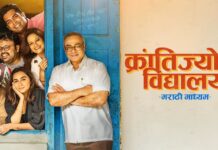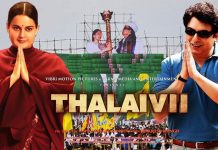SHAHEED-E-MOHABBAT BOOTA SINGH
(Punjabi)
NFDC’s Shaheed-E-Mohabbat Boota Singh (Punjabi) is a true story of a young Sikh armyman, Boota Singh. The film depicts events that took place around 1947 when the Hindu-Muslim riots were at their peak. Boota Singh fell in love with a Muslim girl, Zainub. He married her and a girl-child was born to them. Thereafter, India and Pakistan arrived at an agreement under which Muslim and Sikh girls, who were to be evicted, could be repatriated. As a result, Zainub had to return to Pakistan, leaving behind her husband and daughter. Boota Singh had to run from pillar to post to get Zainub back but he failed. He even reached Pakistan and met Zainub’s father to convince him about their marriage. But he beat him up. Boota Singh was then falsely implicated in an immigration case. Upon hearing Boota Singh’s tale, the judge assured him that if Zainub corroborated his story, she would be restored to him. However, Zainub, when brought before the court, refused to recognise him because she had been threatened that her nod in agreement would cost her husband his life. The judge then asked Boota Singh to return to India. Heartbroken, Boota Singh jumped before a running train with his daughter. He died but the daughter had a miraculous escape. Zainub, too, died immediately thereafter. Later, a letter addressed to Zainub revealed Boota Singh’s last wish that he be cremated in Zainub’s village. Overnight, Boota Singh became a martyr in the eyes of the Pakistanis and they decided to fulfil his last wish. They also made a trust in his name to take care of his daughter.
The film, which reminds of Train To Pakistan, is excellent in all respects. The screenplay (Suraj Sanim) is brilliant and the narration, smooth. The first half is gripping and the second half abounds in emotions.
Gurdas Maan is very good as Boota Singh. Divya Dutta lives the role of Zainub and gives an award-winning performance. Her emotional scenes move the viewer to tears. Raghuvir Yadav, as the lunatic, is extraordinary and his last scene when he is killed by the Muslims is both, chilling and shocking. Aroon Bakshi is good as the faquir in the mosque. The rest of the cast is mostly new and performs ably.
Directorially, Manoj Punj deserves all the praise for handling a sensitive love story with aplomb. Cinematography (Pramod Mittal) is par excellence. Technically, it is so good that it does not look like a Punjabi film at all. Amar Haldipur gives a super-hit music score with at least two songs, especially ‘Ishq da Rabba’, being excellent. Late Nusrat Fateh Ali Khan’s renditions will be a big draw. Production and technical values are excellent.
On the whole, Shaheed-E-Mohabbat Boota Singh will prove to be a hit.
P.N. LAKHANI DEAD
P.N. Lakhani of Lokendra Talkies, Ratlam, and brother of Ramesh and Haresh of Sagar Talkies, Baroda, expired on 27th December in Baroda. The funeral was held in Ratlam. It was attended by many distributors of Indore as well as local trade people of Ratlam.
Both, Lokendra (Ratlam) and Sagar (Baroda), remained closed for four days.
PUNJAB GOVT. HONOURS FOR GURDAS MAAN, PREETI SAPRU
Gurdas Mann and Preeti Sapru will be honoured with the Punjab Ratna by the Punjab government today (2nd January). Ex-prime minister of India, I.K. Gujral will hand over the awards to the Punjabi film actor and actress. Other recipients include Punjab chief minister Parkash Singh Badal, ex-finance minister Manmohan Singh and athlete Milkha Singh.
‘FIRE’ SCREENING: CONTEMPT PETITION BEFORE SC
The Supreme Court will hear the contempt petition of Dilip Kumar and others in the matter of Fire screening, on 4th January. The group of persons who had filed a petition in the apex court last month to ensure the screening of Fire in cinemas under secure conditions, has now filed a contempt of court petition. The group has sought to launch contempt proceedings against the Maharashtra government for failing to ensure the film’s release, in violation of the apex court’s order in their earlier petition. A division bench of the Supreme Court headed by Chief Justice A.S. Anand will hear the petition.
It may be mentioned here that despite the Court’s order, cinemas in Bombay are unwilling to screen the film for fear of violence by Shiv Sena which had objected to the film’s screening in a violent manner.
‘SATYA’ SILVER JUBILEE CELEBRATED
Ramgopal Varma and the team of Satya celebrated the silver jubilee of the film on 26th December, 1998 at the Taj Mahal Hotel, Bombay. The celebratory party was attended by Rekha, Raveena Tandon and the entire cast of Satya including Urmila Matondkar and Chakravarthy who flew from Hyderabad specially for the occasion.
The party, which commenced with a song from Varma’s forthcoming project, Mast, was compered in colloquial Bambaiyya Hindi. Varma thanked his entire team for their efforts while addressing them at the party.
YOU ASKED IT
What is your new year resolution?
– To see at least fifteen hit and super-hit Hindi films in 1999. The best part of my resolution is that the industry has to try hard to make me fulfil my resolution!
When will Rakesh Roshan’s Kaho Naa…Pyaar Hai be released?
– In August this year, the month which will also see the release of Subhash Ghai’s TAAL.
Why has the C.P. Berar distributor (Narsingdas Laddha) relinquished the distribution rights of Aa Ab Laut Chalen?
– Because he is planning to close down his distribution office. He keeps very busy with his other business interests.
DO YOU KNOW?
* Even as the Ghapla hai song of Gulzar’s HU TU TU is gaining in popularity day by day, a controversy over its lyrics has arisen. When translated in English, the song amounts to saying that there is a scam in everything these days. One line of the song goes as Bank mein ghapla, LIC mein ghapla. The Life Insurance Corporation (LIC) has expressed its displeasure over the lyrics and objected to the song.
* Madanlal Chowdhury, the producer of SOMAWATI AMAVAS, died recently in Bombay. His film has been incomplete since 10 years and during this time, its director, K. Bharti, hero, Sheel Kumar, and music director, Hansraj Bahl, have died. The film’s heroine, Jaya Kaushalya, has since shifted to Switzerland. Another hero of the film, Shahi Kapoor (look-alike of Shashi Kapoor), is into hotel business.

Film Weather: 1998
♦ A total of 138 films were released during the year. Of them, less then 24 proved to be earners for their distributors.
♦ Kuch Kuch Hota Hai proved the most memorable hit of the year and one of the biggest blockbusters to-date. The other universal hits were Pyaar To Hona Hi Tha, Pyaar Kiya To Darna Kya and Soldier. Ghulam and Satya proved runaway hits in Bombay and Maharashtra.
♦ Disasters of the year included Qila, Jeans (dubbed; the original Tamil version was a success), Prem Aggan, Doli Saja Ke Rakhna and Dil Se...
♦ Four songs — Chhaiyyan Chhaiyyan, Aati kya Khandala, Kuch kuch hota hai and O O jaane jaana became veritable anthems of the country due to their hit music and catchy lyrics.
♦ Announcements and launchings of films were few due to the tight money market. A shortage of releases is likely to be felt in 1999.
♦ Many big producers refrained from showing their films to their distributors before release. Distributors were agitated but helpless.
♦ Shah Rukh Khan continued to be the topmost hero despite two flops he had. His Kuch Kuch Hota Hai proved to be a runaway hit. In the Overseas too, Shah Rukh is a phenomenon. A perfume of his name was launched in India to cash in on his popularity. Zeenat Aman is the only other star who had a perfume in her name. Among heroines, Kajol was the undisputed queen and was acclaimed for her memorable performances during the year. Salman Khan was the actor who delivered only hits during the year.
♦ The film industry was granted industry status in May by the BJP government at a national conference on ‘Challenges Before India Cinema’ held in Bombay on 10th May. But beyond the granting of the status, no advantages therefrom have accrued to the industry.
♦ Asha Parekh was appointed chairperson of the Central Board of Film Certification for three years. She succeeded Shakti Samanta and is the first lady to occupy the chair. Many in the industry felt that censorship had become difficult under her tenure.
♦ A print of Raghunath Singh’s Gunda was seized by the police on 15th September from a Bombay cinema. The film was allegedly being screened with uncensored portions. The police case is still on.
♦ For the film industry, 1998 was a year of controversies. And most of the controversies centred around censorship. To begin with, Mira Nair’s Kama Sutra – A Tale Of Love was held up at the CBFC last year (1997) and was finally cleared by the Bombay high court in December, ’97 but the CBFC issued a certificate to the film only on 21st January, ’98. The high court held that as per guidelines of the central government, the CBFC cannot censor visuals in dubbed versions of an already censored film. Since the original (English) version of Kama Sutra was censored on 9th October, 1997, the dubbed Hindi, Tamil and Telugu versions too had to be cleared without effecting any cut in visuals, but the CBFC offered more cuts in the dubbed versions than in the English version. The Bombay high court clarified that the CBFC action was wrong. Deepa Mehta’s Fire was in the thick of a controversy after its release when Shiv Sena members attacked cinemas screening the film in Bombay and Delhi, claiming that the scenes of lesbianism shown in the film were against Indian culture. The I & B ministry then referred the film to the CBFC for re-examination. The film, however, continued to be screened in other parts of the country. In the meantime, Dilip Kumar, Javed Akhtar, Mahesh Bhatt and a few others petitioned the Supreme Court to order the film’s safe screening. Mahesh Bhatt’s Zakhm was cleared after a long censor battle as it dealt with Hindu-Muslim riots. The CBFC chairperson, Asha Parekh, referred the film to the home ministry. Amitabh Bachchan’s Major Saab, which had an army background, got into trouble of a different kind. The chief of the army staff refused to give the film clearance as it was felt, the Indian army had been shown in poor light in the film, and Bachchan had to make changes to suit the army’s demands.
♦ The Bombay film industry downed shutters for a day on 18th August to protest against the state government’s inaction in controlling cable piracy of Hindi films. A procession was taken out from Mehboob Studios to Azad Maidan and the trade-wallahs protested outside the offices of Siticable and In Cable, the two cable TV channels which show new films illegally. The Maharashtra government promised action against wrong-doers but the promises have remained just that.
♦ The Madhya Pradesh film industry also observed a day’s bandh on 1st September and took out a rally in Bhopal to protest against the state government’s apathy towards the film industry. An indefinite closure was planned from 17th September but was ultimately put off.
♦ For producers, satellite rights became such a lucrative territory that some of them minted money by selling the rights for telecasting before the stipulated period of five years from the date of theatrical release of a film. Ghulam, Satya, Gupt and Pardes were among the films which were telecast within months or a couple of years of their premiere release. Distributors of all the circuits raised their voice against this practice which is threatening to become a trend. Several distributors’ associations have proposed levying severe penalties on erring producers.
♦ Musically speaking, the year belonged to Jatin Lalit. Several hits and successful films had their names in the credit titles. Not only did the music director duo compose hit tunes in the biggest blockbuster of the year — Kuch Kuch Hota Hai — but their compositions also contributed in no small measure to the success of such films as Pyaar Kiya To Darna Kya, Pyaar To Hona Hi Tha and Ghulam. Undoubtedly, they were the music directors of the year.
♦ Salman Khan was arrested in Jodhpur for alleged hunting and killing of endangered black bucks in October. He was granted bail after eight days. While the other artistes viz. Saif Ali Khan, Tabu, Neelam, Sonali Bendre and Satish Shah, who were with him when he went hunting, were not put behind bars, a case under the Wildlife Act of 1972 is on against all of them. All the stars were in Jodhpur for the shooting of Rajshri’s Hum Saath Saath Hain.
♦ A cinema reopened in Srinagar on 7th August after almost 10 years. No cinema had been functioning in the Kashmir valley since 10 years due to terrorist activities.
♦ Majestic cinema in Calcutta was gutted in a fire on 3rd November. Fortunately, there were no casualties or else it would have been as gruesome as Delhi’s Uphaar cinema fire tragedy of 1997.
♦ Three new cinemas — Cinestar, Movie Time and Cine Magic — opened in Bombay. A new cinema, Nupur, opened in Aurangabad.
♦ Entertainment tax in Uttar Pradesh was reduced from 125% to 100% from 14th September. Some other concessions were also granted. Similarly, entertainment tax in Rajasthan was reduced from 100% to 50% on low admission rates only.
♦ Tamil Nadu chief minister agreed to crack down on video pirates and to offer entertainment tax concessions to the tune of Rs. 40 crore.
♦ All production activities in West Bengal were suspended in September on a call given by the EIMPA due to non-cooperation and misbehaviour by a few artistes with some producers. The producers’ bandh lasted for about five weeks.
♦ Vinod Khanna won the Lok Sabha elections from Gurdaspur constituency in Punjab. Rajasthani film producer Prabha Thakur won a seat in the Lok Sabha from Ajmer.
♦ Satyajit Ray was posthumously honoured with the Bharat Ratna on 1st March. G.P. Sippy was awarded the National Citizen’s award by president of India K.R. Narayanan. Leading Malayalam film actor Mammootty and veteran actress Zohra Sehgal received the Padma Shri awards. Dilip Kumar received the highest civilian award of the Pakistan government, the Nishan-i-Imtiaz, on 23rd March in Islamabad.
♦ 1998 will go down in box-office history as the year of English films in India. Hollywood blockbuster Titanic did titanic business in the country despite not being dubbed in Hindi. Two more English film made on a small scale — Hyderabad Blues and Bombay Boys — are doing wonderful business in India.
♦ Desh Re Joya Dada Pardesh Joya became the Hum Aapke Hain Koun..! of Gujarati cinema. The business of Govindbhai Patel’s maiden directorial venture has crossed 10 crore in Gujarat and Saurashtra and the film is expected to do 3 to 4 crore more. It proved a blockbuster in Overseas too. If Karan Johar was the Hindi film director of the year, Govindbhai was the Gujarati film director of 1998.
♦ Rajshri group entered the music world by starting a music company, Rajshri Music. Its first non-film album, ‘Yeh Hai Prem’, became a hit.
♦ Film Information completed 25 years on 6th October, 1998.
♦ Film Information organised a seminar on ‘Film Insurance — Trends & Prospects’ on 1st July in Bombay. It was attended by all the leading producers. Subhash Ghai, who was already negotiating with an insurance company for insuring his under-production Taal, finally took insurance policies for the film, its cast etc. Taal thereby became the first commercial Hindi film of Bollywood, to be insured.
♦ Pramod Mahajan took charge as the new Union minister for information & broadcasting in December. He succeeded Sushma Swaraj who gave up charge of the ministry when she was appointed chief minister of Delhi.
♦ The 29th International Film Festival of India was inaugurated on 10th January in New Delhi. Spanish director Carlos Saura’s Pajarico was the opening film. There was a competition section in the fete, for Asian directors. Director Wu Tianming’s The King Of Masks (China-Hong Kong) won the Golden Peacock while Morteza Mehranfar’s Paper Airplanes (Iran) bagged the Silver Peacock. Subhash Ghai’s Pardes was the opening film of the mainstream section of the IFFI and it won the jury’s special award.
♦ Yash Chopra’s Dil To Pagal Hai won the National Award for the best film providing wholesome entertainment, and J.P. Dutta’s Border picked up the award for the best film on national integration. Karisma Kapoor bagged the best supporting actress award for the former film and Javed Akhtar, the best lyricist’s award for the latter film. Govind Nihalani’s Hazaar Chaurasi Ki Maa was adjudged the best Hindi film. Girish Kasaravalli’s Kannada film, Thai Saheb, won the Golden Lotus for the best film. Lyricist Pradeep was given the Dadasaheb Phalke award.
♦ Shekhar Kapur hit the jackpot once again after Bandit Queen, with his second international film, Elizabeth.
♦ Asha Bhosle’s hand prints were embossed in clay for display on the walls of Planet Hollywood, the prestigious theme restaurant run by Hollywood stars.
♦ Rajshri’s Hum Aapke Hain Koun..! had the distinction of being adapted for a stage-play by a foreign producer. The play opened in a London theatre on 11th November.
♦ As if the bad times through which the industry was passing all through the year weren’t enough, the year also snatched away several leading lights of the industry. Among those who expired in 1998 were actors Om Prakash, Lalita Pawar, Ajit, Mazhar Khan, Chaman Puri, Vishnukumar Vyas, Persis Khambatta, Shahid Bijnori, Ruhi Berde, music directors Laxmikant, Shambhu Sen, Raju Naik, music director and playback singer Aparesh Lahiri, lyricist Pradeep, writer-lyricist P.N. Sharma, playback singer Talat Mahmood, writer Agajani Kashmiri, directors Raghunath Jhalani, Ramesh Ahuja, Rajesh Vakil, Shaukat Hussein Rizvi, actor-producer-director Dada Kondke, producer-directors Ram Pahwa, Amarjeet, producers Prem Sethi, Vijay Sippy, writer-director Vishram Bedekar, writer-producer-director Tejnath Zar, action master Akbar Bakshi, cameramen Jaywant Pathare, Ramchandra Das, art director R.K. Handa, sound recordist H.D. Mistry, exhibitors Ram B.C., Sahadev Shah, Madhubhai Patel, Mamasaheb Pimple, distributor-exhibitor Chinubhai Shroff, distributor Ajay Goel and film agent P.D. Shroff.
Film Business In Nepal
Madhuri Dixit’s recent statement that Nepal was a part of India once upon a time, may have had the Nepalis protesting but as far as film circuits go, Nepal is not considered a part of the Overseas circuit; rather, a film is sold for Bihar-Nepal together. The Bihar distributor, in turn, sells the rights for Nepal to local distributors there. Of late, however, several Nepal distributors are keen on dealing directly with producers although the latter still have reservations about selling the Nepal distribution rights before the rights for Bihar are parted with.
OUTRIGHT SALE
The sale for Nepal is generally outright — that is to say, there’s no question of sharing of overflow with the producer if a film clicks in the territory of Nepal.
HINDI LANGUAGE
The country is small with a population of about 20 million only. On three sides, Nepal is surrounded by India and in the north, it has China as its neighbour. Culturally, it resembles Bihar (in India) a lot. The Himalayan snow-capped region constitutes 25% of Nepal, while 35% is covered by mountain ranges. The balance 40% is the terrain region. Except in the Himalayan and interior mountainous regions, Hindi language is not only well understood but it is also spoken by the people. About 70% of cinemas are located in the terrain region.
CINEMAS & CENTRES
Nepal has about 176 cinemas — 119 in towns and cities, and about 57 in villages. These 176 cinemas are spread over about 103 centres. There are 2 ‘AA’ class centres from where business of a hit film can be more than Nepali Rs. 3 lakh. There are about 26 cinemas in these 2 centres in Kathmandu valley. Centres like Birganj, Pokhara, Janakpur and Biratnagar yield shares of over 1 lakh each but less than 3 lakh and can be called ‘A’ class centres. There are in all 7 ‘A’ class centres. ‘B’, ‘C’ and ‘D’ class class centres are 17, 31 and 46 respectively and yield shares between Nepali Rs. 30,000 and 1 lakh (‘B’ class), between Nepali Rs. 5,000 and 25,000 (‘C’ class) and less than Nepali Rs. 5,000 (‘D’ class).
SUNDAY RELEASE
It is mainly Nepali and Hindi films which are released in Nepal. On an average, 20 Nepali films are made every year and the business of a hit could cross Nepali Rs. 50 lakh. Bhojpuri films are usually screened in small centres close to the Indian borders. Every year, about 75 to 80 Hindi films are imported into Nepal. Almost all big commercial Hindi films are released in Nepal simultaneously with their all-India release. Except for a handful of releases on Friday, Hindi films generally open there on Sundays which are working days in the country. The weekly off is on Saturday.
THREE SHOWS
Three shows are conducted daily — 12 noon, 3 p.m. and 6 p.m. There are no night shows held. On Saturdays, one extra show is conducted, in which students are charged at concessional rates.
POOR TECHNOLOGY
Surprisingly, technology hasn’t reached the theatres of Nepal. No cinema of the kingdom is equipped with modern sound systems. Why, there are very few cinemas which are even air-cooled!
RATIO
The ratio of Nepal is generally 5 to 6% of the price for Eastern circuit or 12 to 15% of Bihar (which includes one centre of Bihar viz. Raxaul).
A super-hit film can do a business of Nepali Rs. 30 lakh in Nepal. Three to four prints are generally taken out in the case of big films whereas one print suffices in the case of a small film.
HOT FAVOURITES
Ajay Devgan, Akshay Kumar and Sunil Shetty are the most popular artistes in Nepal. No, the Khans are not as ‘hot’ in the kingdom whose people like simple but fast-paced love stories and action-oriented films.
NO CENTRAL PLACE
Although there are 118 listed distributors of Nepal, the prominent and regular ones number about 15. All the regular distributors are exhibitors too. Hence, exhibitors dominate the trade. There is no distribution centre like Naaz in Bombay, and the various deals are concluded on telephone. Some Indians also distribute films, working under the licence of Nepalese citizenship but of late, even they prefer selling Nepal rights than distributing films themselves.
NO COPYRIGHT LAW
The funny party is that no copyright laws exists in the kingdom to protect the rights of distributors of Hindi films. Any person can distribute the film after paying the customs fees. The government has nothing to do with the legal rights. Of course, there is an association — the Nepal Motion Picture Association — which regulates business more on ethical and moral grounds. The problem of screening of unauthorised prints is rampant there, too. Prints are smuggled from U.P., Delhi or other border areas after a week or two of a film’s theatrical release. The NMPA has three wings — production (Nepali films), distribution and exhibition.
REGISTRATION A MUST
For registration of a film with the NMPA, one has to submit the producer or world rights controller’s registration certificate/letter, the money receipt and the agreement. A film is not allowed to be released in the kingdom unless it is registered. Of course, unregistered films are released unauthorisedly.
DISTRIBUTORS KEEN TO DEAL WITH PRODUCERS
Actually, till two years back, distributors of Nepal used to acquire films from Bihar distributors, but with more and more cases of double-dealing, delayed deliveries and last-minute price hikes by Bihar distributors, Nepal distributors turned to Bombay producers and they prefer buying films directly from them. The current status is one of confusion. While Nepal distributors are keen to deal directly with Bombay producers, the latter feel safer to sell Bihar-Nepal together or, at least, Bihar before Nepal. The NMPA has been requesting producers to deal with Nepal distributors directly and has assured producers that in the case of any problems, it (NMPA) would mediate.
VIDEO & CABLE PIRACY
Because of the absence of copyright laws, illegal videos flood the Nepal market soon after a film’s theatrical release, and the latest films are also shown on cable TV almost immediately. But as in India, distributors watch this misuse of rights helplessly. The only difference is that in India, there are laws which are not implemented to protect one’s rights, while in Nepal, even laws do not exist.


FILM INFORMATION’S BESTS OF 1998
Best Film
KUCH KUCH HOTA HAI
Best Producer
YASH JOHAR
(Kuch Kuch Hota Hai)
Best Director
KARAN JOHAR
(Kuch Kuch Hota Hai)
Best Actor
SHAH RUKH KHAN
(Kuch Kuch Hota Hai)
Best Actress
KAJOL
(Kuch Kuch Hota Hai)
Best Supporting Actor
MANOJ BAJPAI
(Satya)
Best Supporting Actress
RANEE MUKERJI
(Kuch Kuch Hota Hai)
Best Villain
ASHUTOSH RANA
(Dushman)
Best Comedian
JOHNY LEVER
(Jab Pyaar Kisise…)
Best Story
KARAN JOHAR
(Kuch Kuch Hota Hai)
Best Screenplay
KARAN JOHAR
(Kuch Kuch Hota Hai)
Best Dialogue
KAMLESH PANDEY & N. CHANDRA
(Wajood)
Best Music Director
A.R. RAHMAN
(Dil Se..)
Best Lyricist
ANAND BAKSHI
(Jab Pyaar Kisise Hota Hai)
Best Song
CHHAIYYAN CHHAIYYAN
(Dil Se..)
AATI KYA KHANDALA
(Ghulam)
Best Playback Singer (Male)
SUKHWINDER SINGH
(Chhaiyyan Chhaiyyan – Dil Se..)
Best Playback Singer (Female)
LATA MANGESHKAR
(Jiya Jale – Dil Se..)
Best Background Score
SANDEEP CHOWTA
(Satya)
Best Action Director
TINNU VERMA
(Salaakhen)
Best Sound
SONA CHOUDHARY
(Satya)
Best Publicity
PYAAR TO HONA HI THA & JAB PYAAR…
Best Cinematographer
ASHOK KUMAR
(Jeans)
Best Choreographer
FARAH KHAN
(Chhaiyyan Chhaiyyan – Dil Se..)
Best Editor
APOORVA BHANU
(Satya)
Best Female Newcomer
PREITY ZINTA
(Dil Se.. & Soldier)
Best Child Actor
Master PARZAN DASTUR
(Kuch Kuch Hota Hai)
Best Climax
DOLI SAJA KE RAKHNA
(Priyadarshan)
Best Scene
Shah Rukh & Kajo’s meeting after 8 years,
at the summer camp in Simla in
Kuch Kuch Hota Hai
Distributor of the year
G.D. MEHTA
(Bobby Art International, Delhi – Films released:
Kama Sutra, PKTDK, Major Saab, Bandhan, Soldier, Fire)
CLASSIFICATION
(Total 138 films, including 30 dubbed films)
AAA (Super-Duper Hit)
KUCH KUCH HOTA HAI
AA (Hit)
–
A1 (Hit)
PYAAR TO HONA HI THA (‘AA‘ in Bombay)
PYAAR KIYA TO DARNA KYA (‘AA‘ in Bombay)
SOLDIER (‘AA’ in East Punjab)
A (Semi-Hit)
BANDHAN (‘A1’ in several circuits)
DULHE RAJA (‘AA‘ in Bihar)
BB (Overflow)
JAB PYAAR KISISE HOTA HAI
GHULAM (‘AA‘ in Bombay)
BADE MIYAN CHOTE MIYAN
FIRE (dubbed)
MAUT
MURDA
MIYAN BIVI AUR WOH (dubbed)
B1 to BB (Commission-Earner to Overflow)
MAJOR SAAB (‘A’ in Delhi-U.P.)
KAMA SUTRA – A TALE OF LOVE (dubbed)
AUNTY NO. 1
RATREE MILAN (dubbed)
B1 (Commission-Earner)
SATYA (‘AA‘ in Bombay and C.P. Berar and losing in several circuits)
SPEED 2 (Ab Samandar Pe; dubbed)
DO NUMRI
B to B1 (Coverage to Commission-Earner)
TOMORROW NEVER DIES (dubbed)
CHANDAAL
B (Coverage)
GHARWALI BAHARWALI (losing in some circuits)
MARD
SHAITANI AATMA
SHER-E-HINDUSTAN
GUNDA
ARMAGEDDON (dubbed)
THE REST
………..
3-E
Education-Entertainment-Enlightenment
Bolder Or Tougher?
For all the CBFC’s claims of becoming more liberal and all that, the facts speak otherwise. A cursory look at the films released last year reveals that 1998 saw an awfully high number of films certified in the ‘A’ and the ‘UA’ categories. Out of the 138 films released in 1998, as many as 64 films (46.38% of the total) were given ‘A’ certificates while 44 (31.88%) were given ‘UA’ certificates. Only 30 films (21.74%) were shown to unrestricted audience. The question that arises is whether our filmmakers are getting bolder or the CBFC is getting tougher?
All For The Item’s Sake
In our industry, the moment someone succeeds in something different, others follow suit. Take the case of Aamir Khan lending his voice to the Aati kya Khandala song in Ghulam. Ever since the song became a rage among the masses, we hve been hearing of several producers and directors trying to ape its success by having their stars to render songs in their voices for their films. So, it doesn’t really come as a surprise that producer-director Vimal Kumar is also planning to have a song recorded in the voices of the artistes of his Rajaji. Govinda, Raveena Tandon and Satish Kaushik will sing for Rajaji a song, penned by Gufi Paintal. The item song has lyrics like Apun ka item (!!) and it will be set to tune by Surya Kamal, who, incidentally, is the son of veteran composer Raj Kamal.
Aa Ab Dub Karen!
While Suman Ranganathan’s dialogues in Rishi Kapoor’s Aa Ab Laut Chalen have finally been dubbed — by TV actress Simone Singh — it would interest readers to know that television VJ Ruby Bhatia (who has an accent as was required for Suman’s character) demanded a few lakhs of rupees to dub for Suman! Actress Neelam, who also has a phoren accent, politely declined to try out her voice, saying that she found dubbing too tiresome.
Andar Baahar
It was a scene straight out of a Hindi film. Four men, armed with revolvers, barged into an office on the 3rd floor of Naaz Building in Bombay on 28th December. The driver of a distributor-exhibitor, who was standing in the lobby, was slapped by one of the group of four gangsters. A lady in the office was pushed and manhandled. A couple of other trade people sitting in the nearby office, were also pushed. The gangsters demanded to know where a particular person, who they identified with a name, was. But the fact is that nobody by that name works in the office into which they entered. As fast as they had come into the office, the foursome went out without any plausible rhyme or reason. Maybe, they realised, they were at the wrong place. Or maybe, they feared, someone may have alerted the police. Or maybe….. well, it could be anything. But the fact is that nothing seriously untoward happened.
Making A Mountain Out Of A Mole-Hill
It is really strange that the Nepali nationals should have taken so much offence at an innocuous mistake committed by Madhuri Dixit. The actress, at a recent press conference in Kathmandu, said that Nepal was a part of India earlier. This statement irked the Nepalis and some of them even took out a procession in protest! Perhaps, what must have prompted Madhuri, a student of science, to err in her history is the fact that Bihar territory in filmi parlance includes Nepal too. Or maybe, it was a plain misconception. Whatever the reason for the mistake, the reaction of the Nepalis seems to be more outrageous than the action of the actress.
Bhaago Bhoot Aaya
Bhoot, Bhootni, Bhoot Raaj, Bhoot Bhootni Aur Shaitan, Bhoot Ki Shaadi, Kunwara Bhoot, Ichhadhari Bhoot… These are only a few of the — hold your breath! — forty-odd Hindi horror films that are being made at present. Even if half of these films manage to find a release this year, we may well have a bonanza of ghost-stories. Quite a ‘horror’scope for the new year, eh? Consider yourself warned…..
Truly Speaking
The perfect way to celebrate the silver jubilee of Satya last Saturday (26th December) at Taj Mahal Hotel would have been to make an underworld don the chief guest. Invitees should not have been greeted with handshakes but rather with swear-words, slaps and fisticuffs. The dinner menu should have had items like Ghoosa (instead of Ghost), Mukka (instead of Makkai), Jhaapat (instead of Jhinga Kadi), Laafa (in place of Lobster), Thappad (in place of Papad) etc. And dessert should have been only Supari. So that Ramgopal Varma could have said: “Maine guests ko supari di hai.”






























